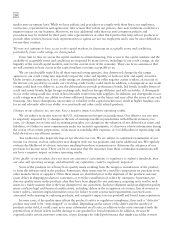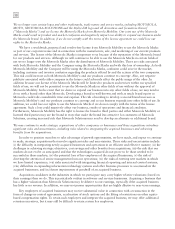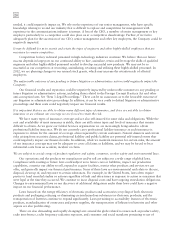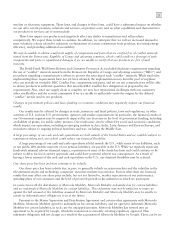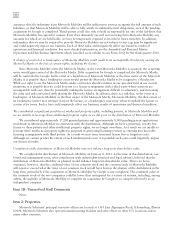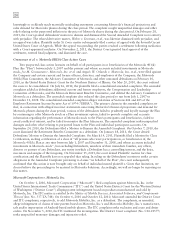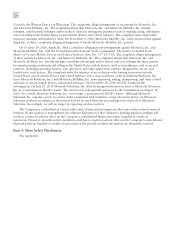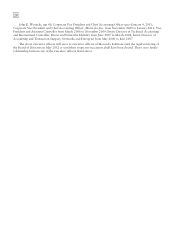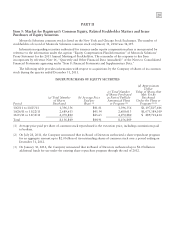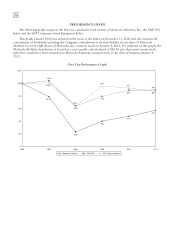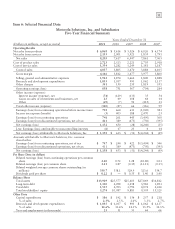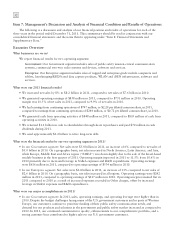Motorola 2011 Annual Report Download - page 29
Download and view the complete annual report
Please find page 29 of the 2011 Motorola annual report below. You can navigate through the pages in the report by either clicking on the pages listed below, or by using the keyword search tool below to find specific information within the annual report.
23
As of December 31, 2011, we owned 19 facilities (manufacturing, sales, service and office), 15 of which were
located in the Americas Region (USA, Canada, Mexico, Central and South America) and 4 of which were located in
other countries. As of December 31, 2011, the Company leased 193 facilities, 91 of which were located in the
Americas Region and 102 of which were located in other countries. As of December 31, 2011, we primarily utilized
6 major facilities for the manufacturing and distribution of our products, and these facilities were located in:
Penang, Malaysia; Reynosa, Mexico; McAllen, Texas; Schaumburg, Illinois; Berlin, Germany; and Suzhou, China.
Motorola Solutions generally considers the productive capacity of the plants operated by each of our business
segments to be adequate and sufficient for the requirements of each business group. The extent of utilization of such
manufacturing facilities varies from plant to plant and from time to time during the year.
In 2011, a substantial portion of our products were manufactured in our own facilities in Mexico and
Malaysia. A portion of our manufacturing is done by a small number of non-affiliated electronics manufacturing
suppliers and distribution and logistics services providers, most of which are outside the United States. We rely on
these third-party providers in order to enhance our ability to lower costs and deliver products that meet consumer
demands. If manufacturing in our own facilities, or by third-parties who manufacture and assemble approximately
20% of our products were disrupted, our overall productive capacity could be significantly reduced.
Item 3: Legal Proceedings
The proceedings referenced below refer to Motorola, Inc., our former name, and we have not changed the court
descriptions to refer to Motorola Solutions, Inc.
Silverman Federal Securities Class Action Case
A purported class action lawsuit on behalf of the purchasers of Motorola securities between July 19, 2006 and
January 5, 2007, Silverman v. Motorola, Inc., et al ., was filed against the Company and certain current and former
officers and directors of the Company on August 9, 2007, in the United States District Court for the Northern
District of Illinois. The complaint alleges violations of Section 10(b) and Rule 10b-5 of the Securities Exchange Act
of 1934, as well as, in the case of the individual defendants, the control person provisions of the Securities Exchange
Act. The factual assertions in the complaint consist primarily of the allegation that the defendants knowingly made
incorrect statements concerning Motorola’s projected revenues for the third and fourth quarter of 2006. The
complaint seeks unspecified damages and other relief relating to the purported inflation in the price of Motorola
shares during the class period. An amended complaint was filed December 20, 2007, and Motorola moved to
dismiss that complaint in February 2008. On September 24, 2008, the district court granted this motion in part to
dismiss Section 10(b) claims as to two individuals and certain claims related to forward looking statements, among
other things, and denied the motion in part. On August 25, 2009, the district court granted plaintiff’s motion for
class certification. On March 10, 2010, the district court granted plaintiffs motion to file a second amended
complaint which adds allegations concerning Motorola’s accounting and disclosures for certain transactions entered
into in the third quarter of 2006. On February 16, 2011, the district court granted summary judgment to dismiss the
remaining claims as to two individual defendants and the Section 10(b) claim as to a third individual, and denied the
motion in part. On March 21, 2011, Motorola filed a motion for summary judgment on the remaining claims
against the Company and other individual defendants. On July 25, 2011, the district court denied the motion for
summary judgment. On February 1, 2012, the parties in the Silverman litigation signed a settlement agreement to
resolve all claims in that case. The agreement has been submitted to the Court and is subject to preliminary and final
approval.
St. Lucie County Fire District Firefighters’ Pension Trust Fund Securities Class Action Case and Related
Derivative Matter
A purported class action lawsuit, St. Lucie County Fire District Firefighters’ Pension Fund v. Motorola, Inc., et
al., was filed against the Company and certain current and former officers and directors of the Company on
January 21, 2010, in the United States District Court for the Northern District of Illinois. The complaint was
amended on June 11, 2010, and again on December 3, 2010. The alleged class included purchasers of Motorola
securities between October 25, 2007 and January 23, 2008. The complaint alleged violations of Section 10(b) and
Rule 10b-5 of the Securities Exchange Act of 1934, as well as, in the case of the individual defendants, the control
person provisions of the Securities Exchange Act. The primary factual allegations were that the defendants



